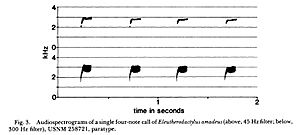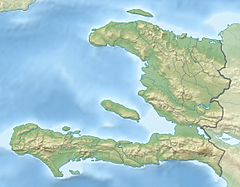Mozart's frog facts for kids
Quick facts for kids Mozart's frog |
|
|---|---|
| Conservation status | |
| Scientific classification |
The Eleutherodactylus amadeus, also known as Mozart's frog or the Haitian robber frog, is a small frog that belongs to the family Eleutherodactylidae. This special frog lives only in one place: the Massif de la Hotte in southwestern Haiti. For many years, people thought this frog might be gone forever, as it wasn't seen after 1991. But luckily, it was found again in 2011!
Contents
Why is it called Mozart's Frog?
This frog is named after the famous composer Wolfgang Amadeus Mozart. Scientists chose this name because the frog's calls sound very musical. When they looked at the sound waves of its calls, they noticed they looked a lot like musical notes!
What does Mozart's Frog look like?
Mozart's frogs are quite small. Male frogs are about 18.7 millimeters (0.74 inches) long from their snout to their rear end. Female frogs are a bit bigger, measuring about 23.4 millimeters (0.92 inches). The longest one ever found was about 25 millimeters (1 inch).
Their backs are smooth. The patterns on their backs can be different. Some have a shape like reverse parentheses, like ")(". Others have no pattern at all. Some have a thin stripe down the middle of their back, along with longer stripes on their sides.
Reproduction and Life Cycle
Male Mozart's frogs make a special call to attract females. It's a single call with four distinct notes. They usually make these calls from low plants or from the ground. Sometimes, two-note calls are heard in the late afternoon, but scientists aren't sure if those are from this same frog species. After it gets dark, only the four-note calls are heard.
Female frogs lay their eggs in clusters under objects on the ground. A single cluster usually has 11 to 12 eggs. Sometimes, an egg cluster might even have eggs from more than one female frog! These frogs have a special way of developing: they don't have a free-swimming tadpole stage. Instead, the eggs hatch directly into tiny froglets. These baby frogs are very small, only about 4.2 to 4.4 millimeters (0.17 inches) long when they hatch.
Where does Mozart's Frog live and how is it protected?
Mozart's frogs live in dense, closed-canopy forests. They prefer high places, from about 1,000 to 2,340 meters (3,280 to 7,680 feet) above sea level. During the day, they like to hide under rocks and logs to stay safe. In the early evening, you can hear the male frogs calling from low plants.
Unfortunately, this frog is in danger because its habitat is being destroyed. People are cutting down trees for charcoal and clearing land for farming. Even though it lives in the Pic Macaya National Park, there isn't enough active work to protect its home. Because of this, its habitat continues to shrink.
After not being seen for many years (since 1991), the Mozart's frog was rediscovered in 2011. This exciting find happened during a special trip that was part of Conservation International's worldwide search for "lost frogs."
See also
 In Spanish: Eleutherodactylus amadeus para niños
In Spanish: Eleutherodactylus amadeus para niños
- List of organisms named after famous people (born before 1800)




